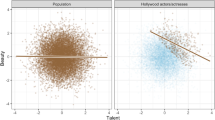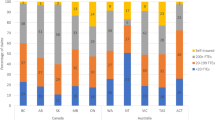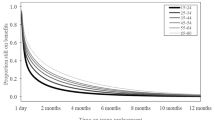Abstract
Purpose Time off work after workplace injury varies by compensation system. While often attributed to features of the compensation system, unaccounted regional factors may drive much of the effect. In this study, we compare disability durations by state and territory of residence within a single national workers’ compensation system. Large differences would indicate that factors other than compensation system settings are responsible for system effects observed in previous studies. Methods We applied crude and adjusted Cox proportional hazards models to compare disability durations by state and territory of residence. Confounders included factors known to influence disability duration. Durations were left-censored at two weeks and right-censored at 104 weeks. Results We analysed N = 31,641 claims. In both crude and adjusted models, three of the seven states and territories significantly differed from the reference group, New South Wales. However, two of the three were different between crude and adjusted models. Regional effects were relatively small compared to other factors including insurer type, age, and type of injury. Conclusions Regional factors influence disability duration, which persist with adjustment for demographic, work, insurer type, and injury confounders. However, the effects are inconsistently significant and fairly small, especially when compared to the effect of confounders and system effects found in previous studies. Regional factors likely only account for a small share of the difference in disability duration between compensation systems.


Similar content being viewed by others
Data Availability
This report uses data supplied by Safe Work Australia and has been compiled in collaboration with state, territory, and Commonweatlh workers’ compensation regulators. The views expressed are the responsibility of the authors and are not necessarily the views of Safe Work Australia or the state, territory, and Commonwealth workers’ compensation regulators.
References
Anema JR, Schellart AJM, Cassidy JD, Loisel P, Veerman TJ, Van Der Beek AJ. Can cross country differences in return-to-work after chronic occupational back pain be explained? An exploratory analysis on disability policies in a six country cohort study. J Occup Rehabil. 2009;19(4):419–26.
Collie A, Lane TJ, Hassani-Mahmooei B, Thompson J, McLeod CB. Does time off work after injury vary by jurisdiction? A comparative study of eight Australian workers’ compensation systems. BMJ Open. 2016;6(5):e010910.
Gray SE, Collie A. Comparing time off work after work-related mental health conditions across Australian workers’ compensation systems: a retrospective cohort study. Psychiatry Psychol Law. 2018. https://doi.org/10.1080/13218719.2018.1473176.
Sowell T. The vision of the anointed: self-congratulation as a basis for social policy. New York, NY: Basic Books; 1995.
Loisel P, Durand MJ, Berthelette D, Vézina N, Baril R, Gagnon D, et al. Disability prevention: new paradigm for the management of occupational back pain. Dis Manag Heal Outcomes. 2001;9(7):351–60.
Krassnitzer L. The public health sector and medicare. In: Willis E, Reynolds L, Rudge T, editors. Understanding the Australian Health Care System. 4th ed. Chatswood, NSW: Elsevier Australia; 2020. p. 18–36.
Collyer F, Willis K, Keleher H. The private health sector and private health insurance. In: Willis E, Reynolds L, Rudge T, editors. Understanding the Australian Health Care System. 4th ed. Chatswood, NSW: Elsevier Australia; 2020. p. 37–52.
Safe Work Australia. Model WHS laws. https://www.safeworkaustralia.gov.au/law-and-regulation/model-whs-laws. Cited 17 Jun 2020
Australian Bureau of Statistics. 6324.0 Work-related injuries, Australia, Jul 2017 to Jun 2018. 2018. https://www.abs.gov.au/ausstats/abs@.nsf/mf/6324.0. Cited 7 May 2020
Shraim M, Cifuentes M, Willetts JL, Marucci-Wellman HR, Pransky GS. Regional socioeconomic disparities in outcomes for workers with low back pain in the United States. Am J Ind Med. 2017;60(5):472–83.
Gaines B, Besen E, Pransky GS. The influence of geographic variation in socio-cultural factors on length of work disability. Disabil Health J. 2017;10(2):308–19. https://doi.org/10.1016/j.dhjo.2016.12.009.
Australian Bureau of Statistics. 2071.0—Census of Population and Housing: Reflecting Australia—Stories from the Census, 2016. 2018. https://www.abs.gov.au/ausstats/abs@.nsf/Lookup/bySubject/2071.0~2016~MainFeatures~Socio-EconomicAdvantageandDisadvantage~123. Cited 17 June 2020
Macpherson RA, Amick BC, Collie A, Hogg-Johnson S, Koehoorn M, Smith PM, et al. Urban-rural differences in the duration of injury-related work disability in six Canadian provinces. J Occup Environ Med. 2020;62(5):e200–7.
Australian Bureau of Statistics. 3218.0—Regional Population Growth, Australia, 2018–19. 2020. https://www.abs.gov.au/AUSSTATS/abs@.nsf/Lookup/3218.0Main+Features12018-19?OpenDocument. Cited 17 June 2020
Collie A, Lane TJ. Australian workers’ compensation systems. In: Willis E, Reynolds L, Judge T, editors. Understanding the Australian Health Care System. 4th ed. Chatswood, NSW: Elsevier Australia; 2019. p. 208–22.
Lippel K, Lötters F. Public insurance systems: a comparison of cause-based and disability-based income support systems. In: Loisel P, Anema JR, editors. Handbook of work disability. New York: Springer; 2013. p. 183–202.
Safe Work Australia. Comparison of Workers’ Compensation Arrangements in Australia and New Zealand. Canberra, AU; 2020. https://www.safeworkaustralia.gov.au/doc/comparison-workers-compensation-arrangements-australia-and-new-zealand-2019.
Commonwealth of Australia. Work Health and Safety Act 2011. Canberra; 2011. http://www.comlaw.gov.au/Details/C2014C00471.
Safe Work Australia. National data set for compensation-based statistics. 3rd ed. Canberra: Safe Work Australia; 2004.
Australian Bureau of Statistics. 2033.0.55.001—Census of Population and Housing: Socio-Economic Indexes for Areas (SEIFA), Australia, 2016. 2018.
Australian Bureau of Statistics. Remoteness Structure. 2018.
Australian Bureau of Statistics. 1292.0—Australian and New Zealand Standard Industrial Classification (ANZSIC), 2006 (Revision 2.0). 2013.
Australian Bureau of Statistics. ANZSCO: Australian and New Zealand Standard Classification of Occupations. 2006;(1220):854.
Australian Safety and Compensation Council. Type of Occurrence Classification System 3rd Edition Revision 1. 2008 (May).
Collie A, Gray SE. ComPARE—Approach to Injury and Condition Coding. AU: Melbourne; 2016.
Lane TJ. Does time off work after injury vary by region? A comparative study of disability durations across Australian states and territories within a single workers’ compensation system. Open Science Framework. 2020. https://osf.io/2umzb/.
Lane TJ, Sheehan LR, Gray SE, Collie A. Regional differences in time off work after injury: a comparison of Australian states and territories within a single workers’ compensation system. Bridges. 2020. https://doi.org/10.26180/5f1933f8dcb6b.
R Core Team. R: a language and environment for statistical computing. Vienna, Austria: R Foundation for Statistical Computing; 2020. https://www.r-project.org/.
RStudio Team. RStudio: Integrated Development for R. Boston, MA: RStudio, Inc.; 2020. https://www.rstudio.com.
Robinson D, Hayes A. broom: Convert Statistical Analysis Objects into Tidy Tibbles. 2020.
Wilke CO. cowplot: Streamlined Plot Theme and Plot Annotations for “ggplot2.” 2019.
Auguie B. gridExtra: Miscellaneous Functions for “Grid” Graphics. 2017.
Firke S. janitor: Simple Tools for Examining and Cleaning Dirty Data. 2020.
Grolemund G, Wickham H. Dates and times made easy with lubridate. J Stat Softw. 2011;40(3):1–25.
van Buuren S, Groothuis-Oudshoorn K. mice: Multivariate imputation by chained equations in R. J Stat Softw. 2011;45(3):1–67.
Tierney N, Cook D, McBain M, Fay C. Naniar: Data structures, summaries, and visualisations for missing data. R Package. 2020.
Lüdecke D, Makowski D, Waggoner P, Ben-Shachar MS. see: Visualisation Toolbox for “easystats” and Extra Geoms, Themes, and Color Palettes for “ggplot2”. 2019. https://cran.r-project.org/package=see.
Therneau T. A package for survival analysis in S. 2015. https://cran.r-project.org/package=survival.
Kassambara A, Kosinski M. survminer: Drawing Survival Curves using “ggplot2”. 2018. https://cran.r-project.org/package=survminer.
Comtois D. summarytools: Tools to Quickly and Neatly Summarize Data. 2020.
Wickham H. tidyverse: Easily Install and Load the “Tidyverse”. 2017. https://cran.r-project.org/package=tidyverse.
Zeileis A, Grothendieck G. zoo: S3 infrastructure for regular and irregular time series. J Stat Softw. 2005;14(6):1–27.
Lane TJ, Sheehan LR, Gray SE, Beck D, Collie A. Step-downs reduce workers compensation payments to encourage return to work. Are they effective? Occup Environ Med. 2020;77:470–7.
Kaplan RM, Chambers DA, Glasgow RE. Big data and large sample size: a cautionary note on the potential for bias. Clin Transl Sci. 2014;7(4):342–6.
Gray SE, Lane TJ, Sheehan LR, Collie A. Association between workers’ compensation claim processing times and work disability duration: analysis of population level claims data. Health Policy (New York). 2019;123(10):982–91.
Collie A, Sheehan LR, Lane TJ, Gray SE, Grant GM. Injured worker experiences of insurance claim processes and return to work: a national, cross-sectional study. BMC Public Health. 2019;19(927):1–12. https://doi.org/10.1186/s12889-019-7251-x.
Shraim M, Cifuentes M, Willetts JL, Marucci-Wellman HR, Pransky GS. Length of disability and medical costs in low back pain: do state workers’ compensation policies make a difference? J Occup Environ Med. 2015;57(12):1275–83.
Shraim M, Cifuentes M, Willetts JL, Marucci-Wellman HR, Pransky G. Why does the adverse effect of inappropriate MRI for LBP vary by geographic location? An exploratory analysis. BMC Musculoskelet Disord. 2019;20(1):1–11.
Hansen B, Nguyen T, Waddell GR. Benefit generosity and injury duration: quasi-experimental evidence from regression kinks. Bonn, Germany; 2017. http://ftp.iza.org/dp10621.pdf.
Lane TJ, Gray SE, Sheehan LR, Collie A. Increased benefit generosity and the impact on workers’ compensation claiming behavior: an interrupted time series study in Victoria. Australia J Occup Environ Med. 2019;61(3):e82-90.
Lane TJ, Gray SE, Hassani-Mahmooei B, Collie A. Effectiveness of employer financial incentives in reducing time to report worker injury: an interrupted time series study of two Australian workers’ compensation jurisdictions. BMC Public Health. 2018;18(100):1–10. https://doi.org/10.1186/s12889-017-4998-9.
Westmorland M, Buys N. Disability management in a sample of Australian self-insured companies. Disabil Rehabil. 2002;24(14):746–54.
Sheehan LR, Lane TJ, Gray SE, Beck D, Collie A. Comparison of return to work practices and outcomes in self-insured and scheme-insured organisations. 2018. https://www.monash.edu/__data/assets/pdf_file/0008/1617281/COMPARE_Self-insurers_with-DOI.pdf.
Seabury SA, McLaren CF, Robert R, Frank N, John M. Workers’ compensation experience rating and return to work. Policy Pract Heal Saf. 2012;10(1):97–115.
Sheehan LR, Gray SE, Lane TJ, Beck D, Collie A. Workers’ compensation claims in government employees. Melbourne, AU; 2018. https://www.monash.edu/__data/assets/pdf_file/0004/1617277/COMPARE_Government-employees_with-DOI.pdf.
Berecki-Gisolf J, Clay FJ, Collie A, McClure RJ. The impact of aging on work disability and return to work. J Occup Environ Med. 2012;54(3):318–27.
Krause N, Dasinger LK, Deegan LJ, Brand RJ, Rudolph L. Alternative approaches for measuring duration of work disability after low back injury based on administrative workers’ compensation data. Am J Ind Med. 1999;35(6):604–18.
Collie A, Di Donato M, Iles RA. Work disability in Australia: an overview of prevalence, expenditure, support systems and services. J Occup Rehabil. 2019;29(3):526–39. https://doi.org/10.1007/s10926-018-9816-4.
Funding
This study was funded by an Australian Research Council Discovery Project grant (DP190102473), as part of the Compensation and Return to Work Effectiveness (ComPARE) Project, and by Safe Work Australia, a government statutory agency that develops national work health and safety and workers’ compensation policy. Professor Collie is supported by an Australian Research Council Future Fellowship (FT190100218).
Author information
Authors and Affiliations
Corresponding author
Ethics declarations
Conflict of interest
We have no conflicts of interest to report.
Ethical Approval
This study received ethics approval from the Monash University Human Research Ethics Committee (CF14/2995 – 2014001663).
Additional information
Publisher's Note
Springer Nature remains neutral with regard to jurisdictional claims in published maps and institutional affiliations.
Rights and permissions
About this article
Cite this article
Lane, T.J., Sheehan, L., Gray, S. et al. Regional Differences in Time Off Work After Injury: A Comparison of Australian States and Territories Within A Single Workers’ Compensation System. J Occup Rehabil 32, 252–259 (2022). https://doi.org/10.1007/s10926-020-09947-2
Accepted:
Published:
Issue Date:
DOI: https://doi.org/10.1007/s10926-020-09947-2




